Online marketplaces are flourishing. Success stories featuring famous B2C marketplace examples like Amazon or eBay are a case in point. So, it is hardly a surprise that ecommerce platforms pop up all over. Still, very few of them can compete with industry leaders as equals.
In fact, building an online marketplace platform is never smooth sailing. Quite the opposite, it can become a challenging task for rookies.
To help you start a successful marketplace business, we created a detailed guide to building a B2C marketplace. Follow these steps to offer the greatest value to your buyers and sellers.
What is an online B2C marketplace?
Let’s start with the term in question and the latest trends related to the e-commerce domain. When the B2C meaning becomes clearer for you, when you know what this domain has to offer, you get better chances to succeed.
So what exactly is business-to-consumer (B2C)? Unlike B2B, B2C targets single customers by selling products to them directly.
The most famous examples of B2C marketplace platforms:
In recent years, marketplaces offering B2C services have been gaining momentum. The recent report by Grand View Research predicts that the global B2C e-commerce market will reach $17.77 trillion by 2030.
So what makes marketplaces so sought-after? Why do consumers prefer to go shopping online rather than visit brick-and-mortar stores?
First, shoppers like the sense of convenience and security the B2C websites bring. They can find and purchase any item they like in no time.
Besides, with the vast adoption of machine learning (ML), consumers have started getting more personalized experiences. They see products tailored to their unique needs or based on their previous purchasing history.
The full list of reasons why customers prefer online shopping looks the following way:
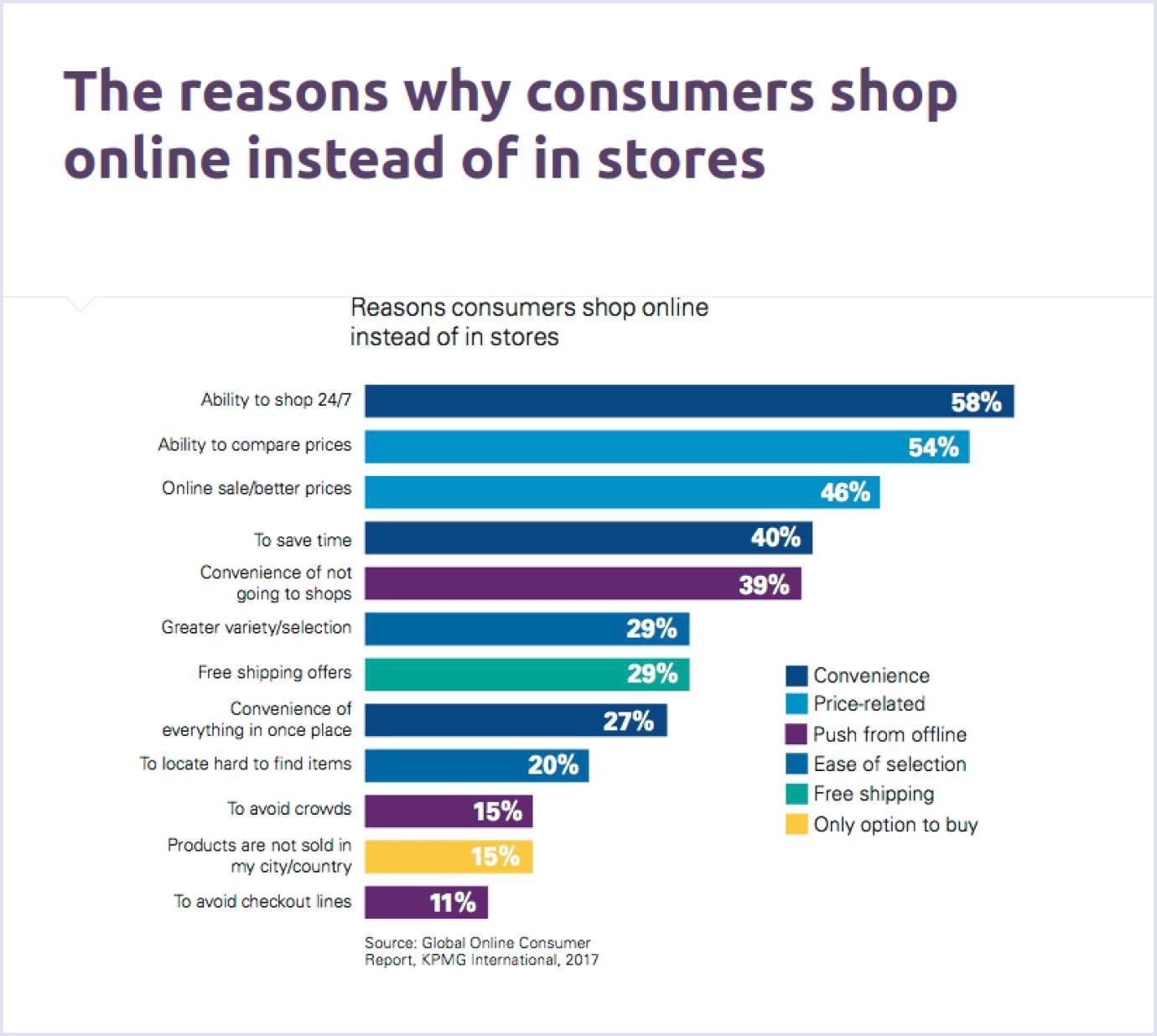
How does the B2C ecommerce marketplace work?
Such marketplaces work like retail stores but with digital advancements. These include predictive product or service search, prompt payments, and convenient delivery.
Although B2C marketplaces mainly sell directly to customers, they can also resell products. Additionally, when a platform serves as a sale place for many vendors, it becomes a hybrid B2C marketplace platform, often called multi-vendor. Such marketplaces offer customers products and services from many providers.
What are the different ecommerce B2C models?
Business-to-consumer models involve different selling strategies. So, here is an overview of the common B2C models in ecommerce that show how such companies and marketplaces build revenue.
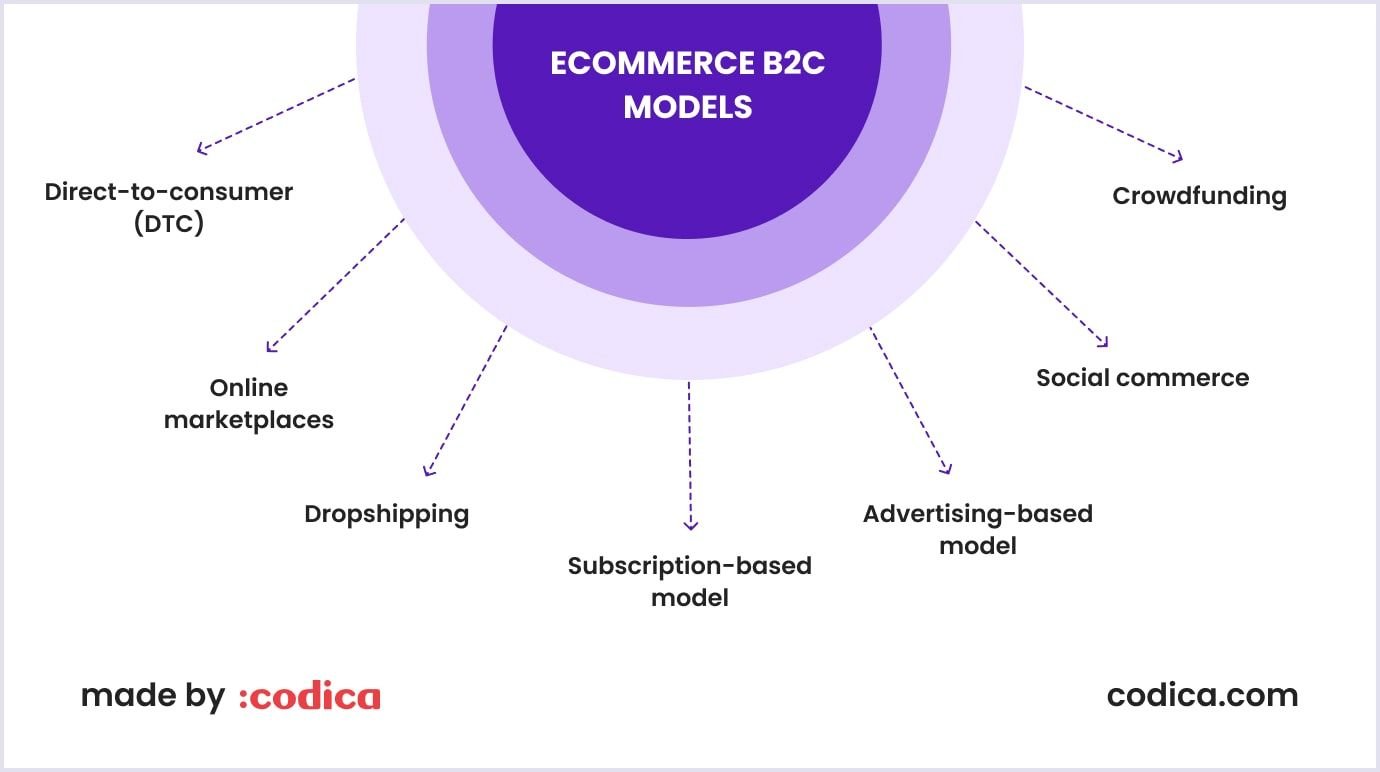
Direct-to-consumer (DTC)
This B2C model means the manufacturer sells directly to end consumers without intermediaries. Such businesses have self-owned spaces and channels to sell to end consumers. So, DTC companies do not have to rely on retailers, wholesalers, or distributors.
Online marketplaces
Such a B2C business model allows you to sell products and services via an online storefront or service platform. Customers enjoy such B2C online marketplaces as they can order products and services, pay for them, and get deliveries promptly.
Dropshipping
This approach involves delivery from a manufacturer to customers by an intermediary. So, a manufacturer only processes orders. Packaging, shipping, and storage are on the intermediary’s side.
Subscription-based model
When you offer products or services for a recurring monthly or annual fee, this is a subscription-based B2C business model. After subscribing, customers can receive products and services regularly while the subscription is valid. If you want to continue receiving products or services, renew the subscription.
Advertising-based model
In a nutshell, ecommerce advertising means placing paid messages on various online sales channels. Such messages raise brand awareness and help persuade customers to buy products on your B2C ecommerce marketplace.
Social commerce
This model allows you to sell and promote products and services via social media platforms. Customers can leave photos, videos, and reviews about products, making the latter visible to a broad audience.
Crowdfunding
With this model, you can raise consumer funding directly to invest in your marketplace development or startup. In return, backers receive early access to products, perks, and rewards.
Now that we know what B2C means and how it works, let’s proceed to the top ten things you should consider before you dig into B2C marketplace development.
1. A validated business idea
It is an ill-advised step to launch an online B2C marketplace without validating your idea first. You can invest lots of money in creating a marketplace that will prove useless to your target audience.
For starters, ponder on the following three questions:
- Why?
Think carefully: why do you want to build a B2C website in the first place? There are dozens of marketplaces on the web and you should have a really solid reason to build another one.
- What?
The next question comes directly from the first one. What issues is your future marketplace designed to solve? Are those problems big enough to be worth solving?
- How?
Finally, define how to differentiate your marketplace from the competitors. To achieve this goal, you need to create a catching unique value proposition (UVP). With a compelling UVP, you can convey the distinctive advantages of your ecommerce marketplace platform to your target audience.
It is advisable to test the actual demand for your platform providing B2C services by interacting with potential users. To begin with, you may ask your folks, friends, co-workers, or business associates for their honest opinions about your venture.
Why should you start with an idea validation?
Let’s discuss the importance of idea validation with the example from our practice.
Our customer David struggled to keep his children busy after school. After communicating with other parents, David realized that finding activities for kids was a widespread problem. So, it was definitely worth solving.

To overcome this issue, David came up with the idea of creating an online platform where parents can find, book, and coordinate activities for their kids.
A well-executed business idea was further translated into a successful software project. Check the full case study to see the results our team achieved in the process of building an online marketplace for parents.
We started collaboration with David when he only had an idea of the platform based on the pain point he wanted to solve. With several product discovery sessions, David and our team together worked on the idea and chose the best way to bring it to life.
A distinctive feature of this project is convenient itinerary management. With its help, program specialists can offer parents the most relevant initiatives based on specific requirements.
Read in detail about the process of creating this platform: How We Delivered MVP for PlanMyKids - Kids Activities Marketplace
2. Comprehensive market research
Conducting market research can help you launch a thriving B2C online marketplace in the following ways:
- It will provide you with the industry outlook.
- The preliminary analysis may help you reveal emerging trends in the digital marketplace industry. These insights will enable you to stay in the loop.
- Market research allows you to understand your target audience better. Conduct a survey with your competitors' customers. Ask them what they like or dislike about visiting those online marketplace platforms. Thus, you will have ideas on the unique value you can offer them.
- Competitors and demand research uncover potential challenges related to the marketplace launch. When you know what issues lie ahead, you can adjust the business strategy accordingly. As a result, you can think of the most suitable solution to fix them.
3. Specific niche
What products or services will be available on my B2C marketplace platform? Should I become everything for everyone, or is it better to focus on a specific niche? You will face this dilemma while working on launching a marketplace website.
There are two options. You can build a horizontal business-to-consumer marketplace like eBay or Amazon. Alternatively, you can invest in a vertical platform like Fiverr or Uber.
The first scenario seems more tempting. However, you will soon realize that the all-in-one approach is gradually losing effectiveness. On the contrary, niche targeting is a more sensible option to start B2C e-commerce.
A clear benefit of niche platforms is their ability to bring consumers a personalized experience. Niche B2C e-commerce websites provide users with a specific solution to a particular issue. For instance, if they need freelance work, they go to Upwork. If users want to obtain certain skills, Udemy or Coursera will be a good help. The list can go on and on.
Finally, the narrower customer base makes creating and executing successful marketing campaigns easier. As a result, you get better chances to promote your B2C e-commerce marketplace more effectively.
A typical example of a vertical online marketplace platform is ThredUP. This website sells high-quality secondhand clothes, helping you take care of the environment.
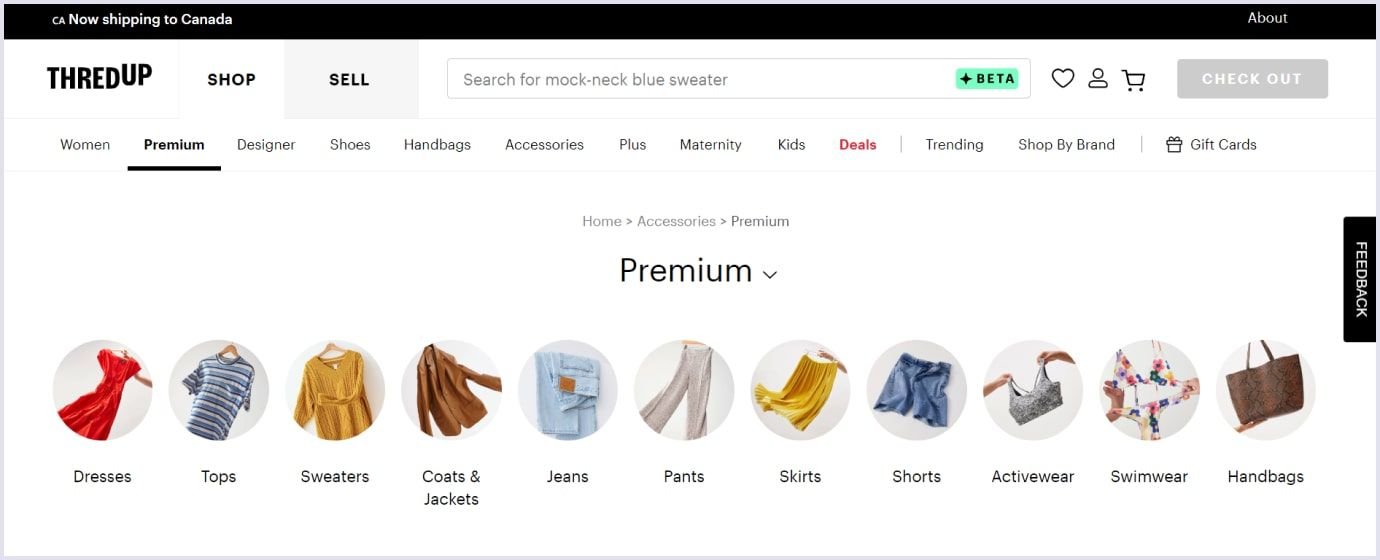
4. The chicken and egg issue
To operate a thriving multi-vendor B2C marketplace, you need many buyers and sellers. Here you will have to put your head to which side you are going to attract first. That is when you face the so-called chicken and egg problem.
Luckily, there are effective user acquisition strategies to kick-start your B2C e-commerce website.
Gaining the hardest side first
You can focus on the hardest side and build a partnership with them instead of trying to get both parties at the same time. The golden rule is that the hardest side is the more valuable one, and typically it involves the supply side that provides value to your platform. As soon as valuable users join your B2C e-commerce marketplace, the other party will follow their lead.
This phenomenon is called the “network effect”. The term was introduced by the venture firm NFX. The video below shows how this principle works.
Set the time or demand constraints
Scarcity is another tactic that can yield you some dividends. Setting time or demand constraints helps create the buzz around your B2C online marketplace products. You encourage customers to take immediate action.
Also, scarce products serve as status symbols. People like the power they get when they own items that are desirable but unavailable to other users.
Lastly, if you limit the supply of some products on your B2C ecommerce platform, buyers consider these goods more popular. They believe that the high demand is the reason for these constraints.
For example, Udemy offers discounts to new learners. On their B2C website, we can see a countdown clock with a limited offer that helps boost sales and define scarcity parameters.
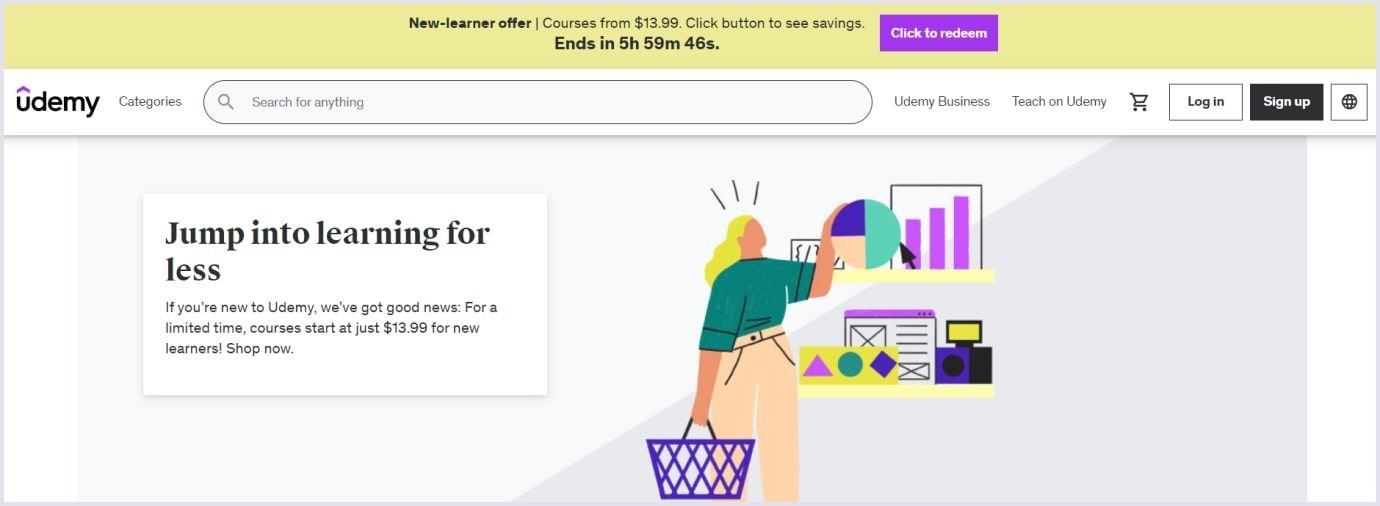
5. The right pricing policy
The next thing you should consider is the B2C business model.
Below is a list of the popular revenue models adopted by famous B2C e-commerce brands.
Commission
By adopting this strategy, you take a specific percentage of each transaction on your B2C e-commerce platform. For example, Rakuten.com charges commission fees varying from 5% to 14.5% depending on the product type.
Advertising
You can sell space on your B2C marketplace to other businesses to promote their products or services. However, try not to pitch it strongly. Graphics and banner ads easily irritate users, and they can leave your platform. To avoid such a mishap, publish commercials only in certain places on your B2C e-commerce website.
Listing fees
This monetization model requires sellers to pay a fee to list their products on your platform. This strategy will work if your B2C e-commerce marketplace offers slow-selling items.
Membership
Provide your paid members with additional opportunities, but be sure to offer them real value. Otherwise, your clients can cancel their subscriptions.
For example, Bonanza offers sellers different benefits based on the membership plan.
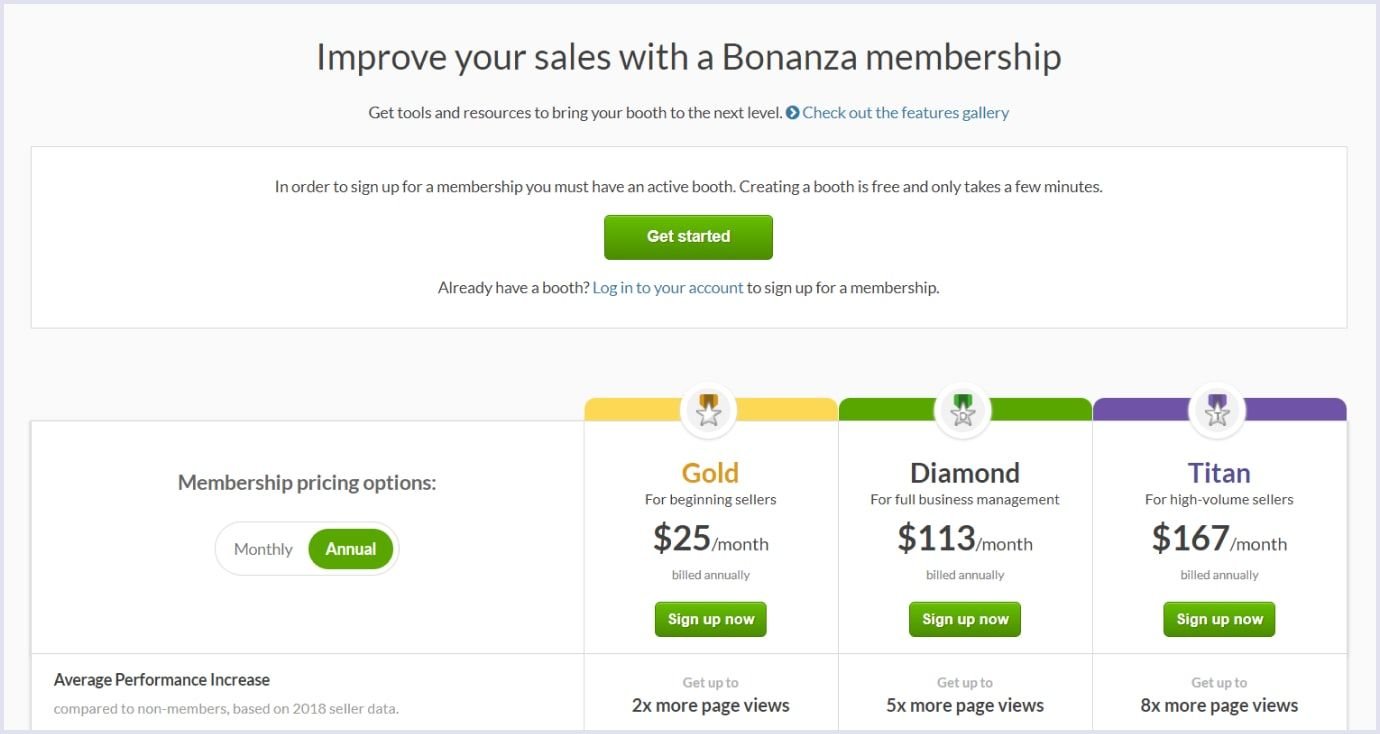
Choose one monetization for a start. Later, when your business-to-consumer marketplace scales, try to adopt other tactics. In the long run, you will find out what monetization methods suit your marketplace perfectly.
6. A minimum viable product
A minimum viable product, or an MVP for short, is a product - a B2C e-commerce marketplace, to be more precise - with a few basic features. It can help you check the feasibility of your idea without investing in a fully-fledged project.
As soon as you build a marketplace website MVP, you can gather feedback from the early adopters. You will gain valuable insights into their needs, wants, and preferences, which will help you understand what should be added/improved/removed on your B2C platform.
Regarding PlanMyKids, David initially focused on building an MVP for his online service marketplace. He knew it was a proven way to go through a project with less risk. With the MVP development service, David could satisfy the basic marketplace requirements with minimum investment.
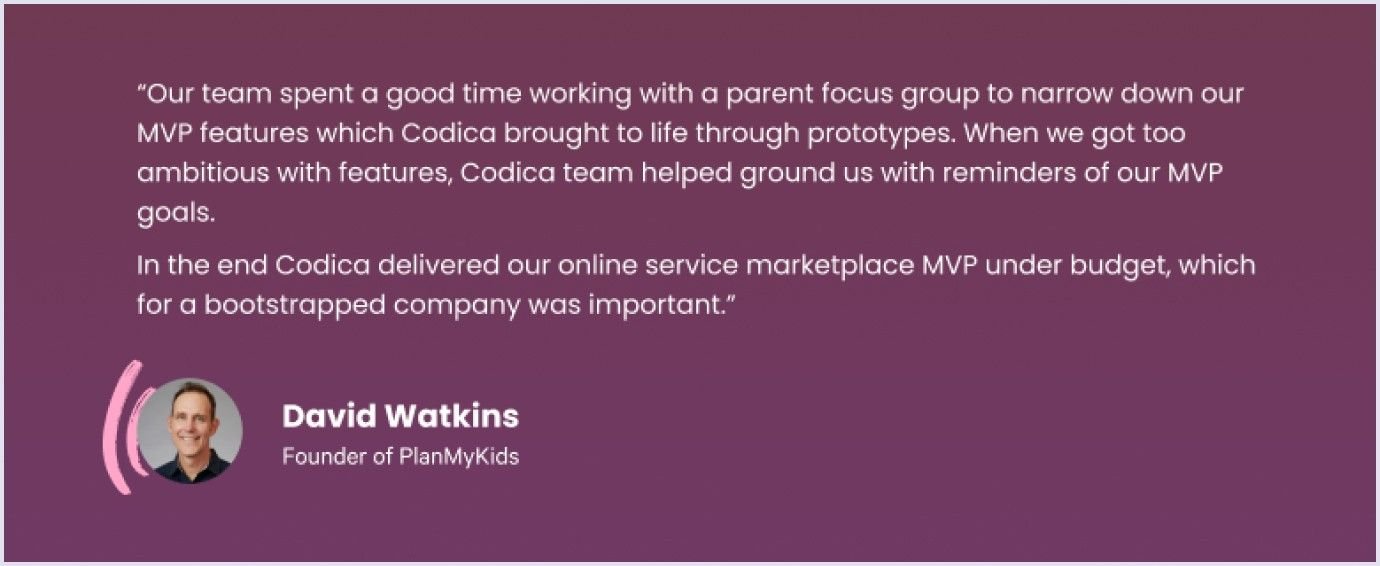
In addition, since a minimum viable product has a limited feature set, it requires less coding. Reducing code means less room for mistakes in product or service marketplace development.
Besides, building a product with one or two key features will not take long. As a result, you will save costs for the marketplace software development services.
When speaking about an MVP for your business-to-consumer website, it should include the following features:
- Administration panel;
- Registration form;
- Social sign-in;
- Shopping cart;
- Multiple payment gateways;
- Product page;
- Account page for both buyers and sellers.

7. Functionality for a full-featured B2C marketplace
Make the enhanced user experience your top priority. If merchants and buyers find your B2C marketplace convenient, they will return for repeat purchases.
We have already discussed the fundamental functionality for your marketplace MVP. What about some advanced features and integrations that can improve user experience?
When it comes to the B2C marketplace structure, consider the following additional features for your fully-fledged product:
Managing listings
Allow B2C e-commerce buyers to update information about their goods and services. Make sure they can change the description, price, and specification.
Filters
They enable visitors to find the desired items quickly and effortlessly.
Wishlist
Allow users to create a list of items they want to buy.
Localization
It would be a good idea to cater to buyers worldwide and allow them to choose their country, language, and currency.
Notification system
The push notifications system keeps buyers updated on your products and services.
Chat and messengers
Provide both parties with the tools for instant communication.
Security features
B2C e-commerce brands take serious measures to safeguard their platforms. Thus, identity verification is a great way to prevent fraud and mitigate risks.
Also, you can protect your multi-vendor B2C marketplace with the help of email or IP blocking, login history, and limited login attempts.
System of rating/reviews
Allow users to leave honest reviews. This way, you will increase the credibility of your business-to-consumer website.
The ratings and reviews on the Overstock website help buyers make an informed purchasing decision. They can choose high-quality furniture that will fit in their apartment.
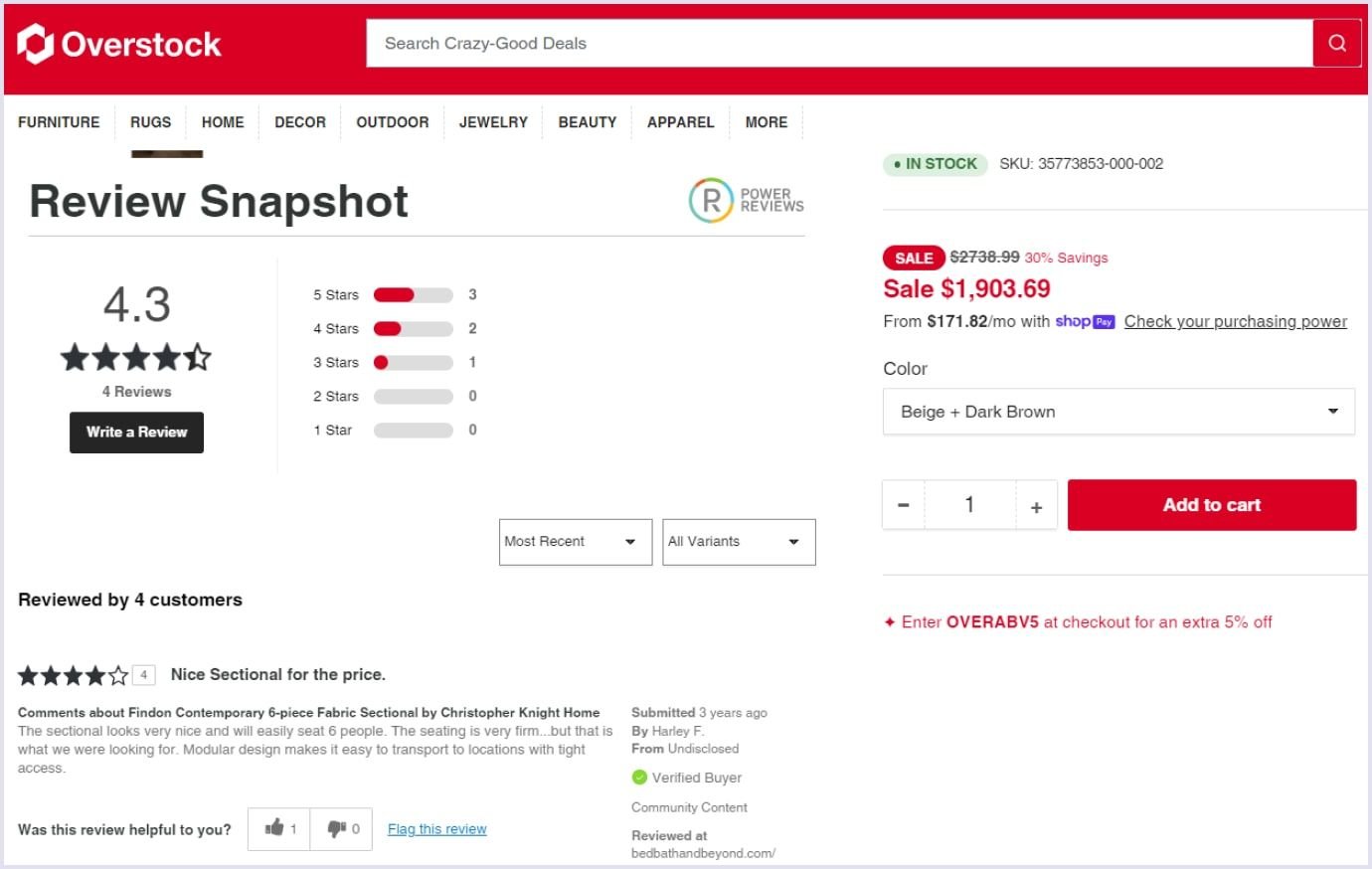
8. B2C marketplace software development approach
Finally, you must decide how to build your B2C e-commerce website. Will you turn to a custom software development firm to create your marketplace? Will you charge your in-house team with this task? Do you have reliable co-founders? Or will you build your business-to-consumer website by yourself?
You have two options: develop a B2C marketplace from scratch or use ready-made solutions.
Let’s see the core idea behind each approach.
Out-of-the-box solutions are a more cost-effective option than bespoke software. Such B2C e-commerce marketplaces can be launched right after the purchase. They offer a generic set of features and are regularly updated by the vendor. Besides, manuals, guides, and best practices will be a good help if you have some questions.
However, basic functionality provided out of the box may not be enough. It will not satisfy the specific needs of your B2C e-commerce customers. Besides, the updates can be worthless since the service providers may add features that are not suited for your business.
Custom software development, in turn, will bring you a unique product tailored to your specific business needs.
The thing is that custom marketplace development companies have extensive experience in building web solutions for different domains. They will analyze your project idea and provide the proper B2C marketplace functionality and the most advanced technology stack.
Codica's expert team delivers successful custom web products for our clients from all over the world. Recently, we helped a customer build a tailored recruiting platform for the Netherlands market. The intelligent job search system allows users to find relevant vacancies based on their skill level and preferences.
9. Optimization for mobile devices
Recent findings by Statista state that in 2024, 9.2% of retail commerce in the USA will be generated via m-commerce. This type of ecommerce allows you to buy and sell via apps or mobile websites using smartphones and tablets.
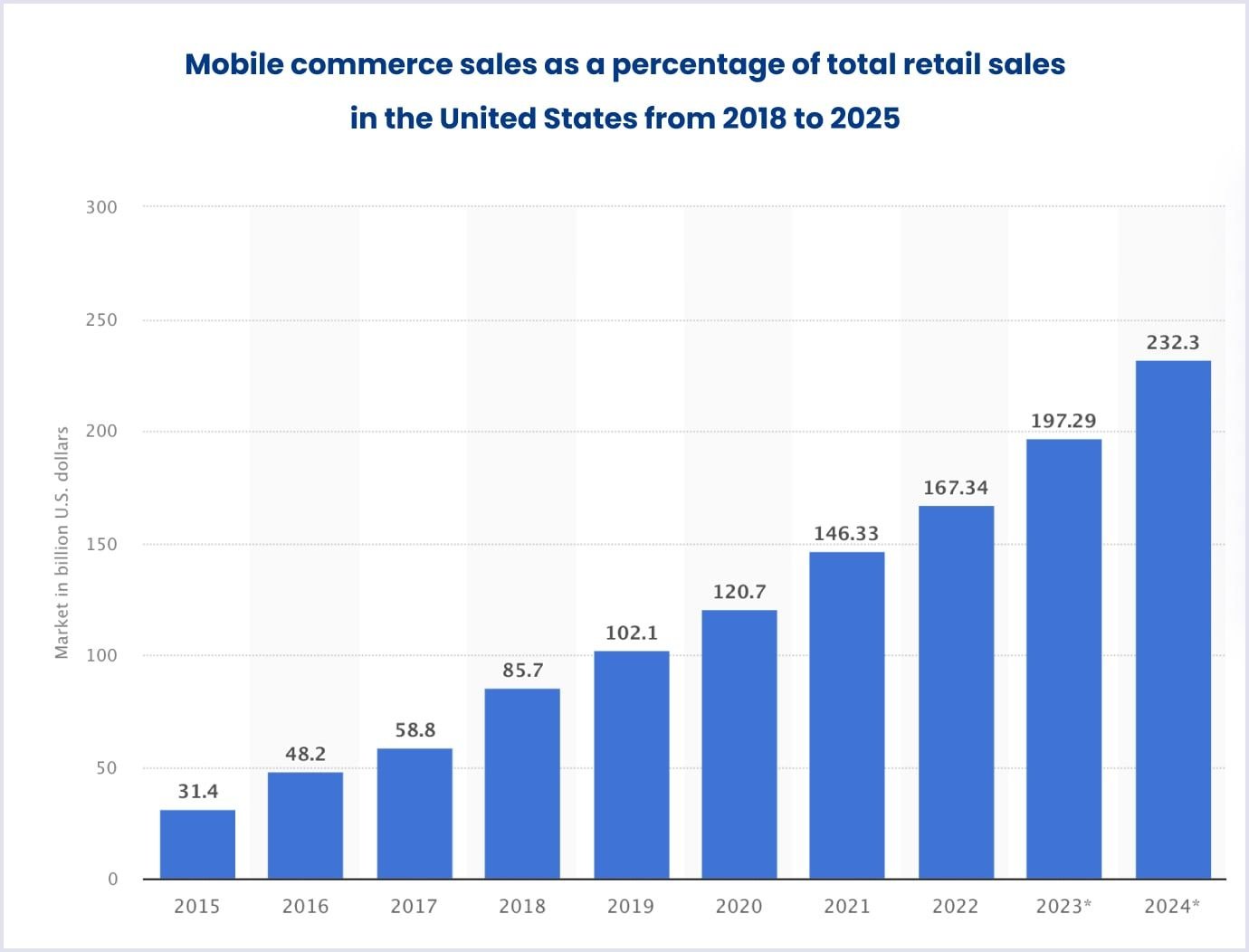
This data gives a solid reason for making mobile optimization of the B2C marketplace platform your priority.
Think of a user-friendly mobile design for your B2C platform. Enable users to purchase goods from their smartphones and tablets quickly and conveniently. This way, you will make the buyer's experience smooth and straightforward.
Things that deserve your special attention:
- Easy and intuitive navigation of your B2C e-commerce marketplace;
- Easy checkout process. It is advisable to break it into several steps;
- Digital wallets such as ApplePay and AndroidPay;
- Fast-loading cross-platform PWA website, which can work as a great alternative to native mobile apps.
Speaking about Codica’s experience, we always recommend that our clients focus on the mobile-first approach. Therefore, our web products, including progressive web applications, are designed with mobile devices in mind.
For example, one of our recent projects is an insurance progressive web app we have built for Babel Cover. Thanks to the PWA development services, we have helped our customer to launch quickly and save costs on mobile app development.
10. Efficient techniques to promote your B2C marketplace
The work on the online marketplace platform does not stop after its launch. You should constantly invent creative ways to attract users to the marketplace to grow your business.
Here you can find some of the most efficient promotion strategies that will help you to grow your online presence and acquire new customers.
Social networks
Today B2C brands actively use X (Twitter), Instagram, or Facebook to interact with their audience. They publish product promos, hold contests, and announce the launch of new goods or services. Businesses build a community of loyal customers this way.
Social media promotion of your B2C e-commerce platform offers an easy way to interact with your customers and grow their engagement.
Email marketing
After launching a B2C marketplace platform, you start looking for simple, efficient, and cost-effective ways to attract more users to your platform. Email marketing satisfies all those requirements.
However, with a brand-new marketplace, you should first grow your email list. To this end, you can offer users valuable resources (e.g., a video course, PDF, or guide) in exchange for their email addresses.
Search Engine Optimization
All content on your online B2C marketplace, such as product descriptions, titles, and images, should be SEO optimized. Thus, your platform will rank higher in search results and have a better chance of being spotted by real customers.
How can Codica help you with B2C marketplace development?
Since 2015, Codica has been helping customers grow their B2C marketplace business with stable and powerful web solutions.
We are proud that our hard work and dedication to customers' success are duly appreciated. Thus, Clutch listed us among the Top Developers in 2023.
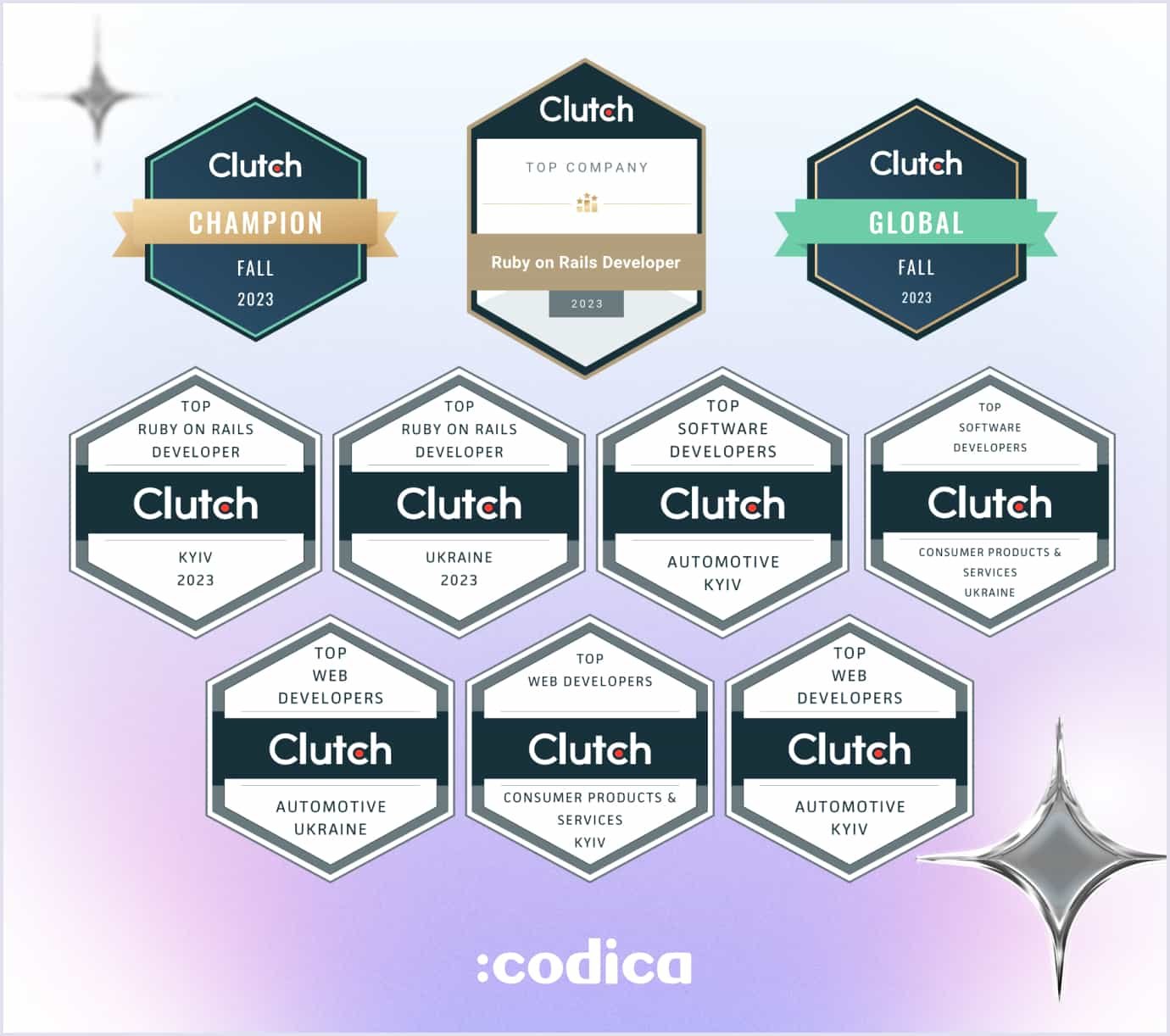
We understand the importance of mobile-first marketplace design. For this reason, all the marketplaces our team builds are adapted for mobile devices by default.
Besides, we ensure the security and reliability of the products we create. Our advanced technology stack, including Ruby, Ruby on Rails, React, and Vue.js, allows us to develop solutions corresponding to the latest web standards.
Over the years, we have successfully delivered many ecommerce projects for many domains. One of the multi-vendor marketplace development projects our team is proud of is the first vehicle marketplace in Africa.
This automotive marketplace lets users buy and sell cars, motorbikes, and trucks online. The platform comprises 90+ fully customizable websites in 15 local languages, processing transactions in 72 currencies. It is fast-loading and optimized for mobile devices.

Bottom line
We have specified all points that you should consider before building a B2C marketplace. We discussed B2C meaning, defined the common revenue models and features. Equipped with this valuable information, you stand a good chance of launching a thriving B2C marketplace with lots of benefits.
For inspiration, look at our portfolio of projects the Codica team has delivered to clients worldwide.
If you need assistance with online marketplace development, feel free to contact us. Our expert team will eagerly build a unique, high-quality, and successful B2C marketplace for you.
